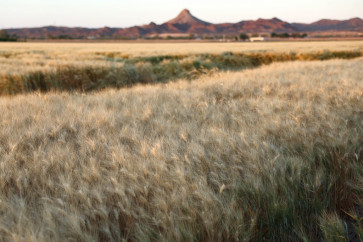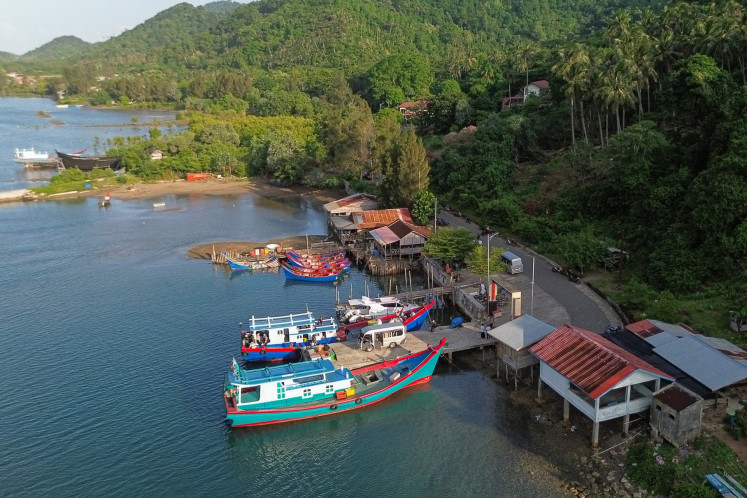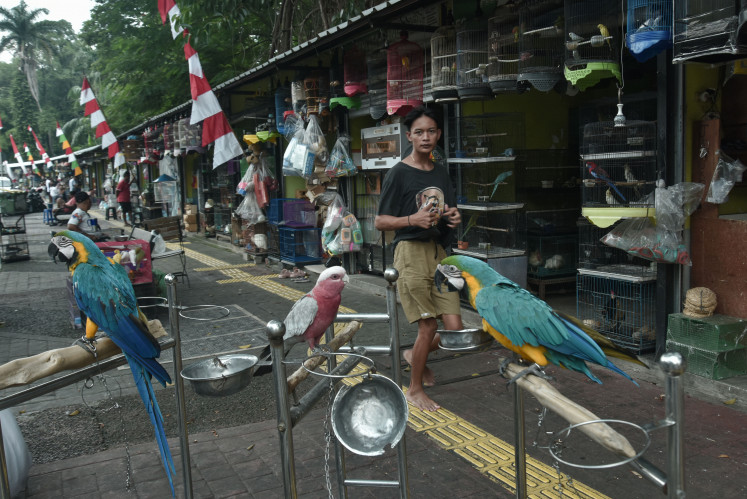Popular Reads
Top Results
Can't find what you're looking for?
View all search resultsPopular Reads
Top Results
Can't find what you're looking for?
View all search resultsEco-printing impresses women of Yogyakarta
Beauty in nature: Eco-printing instructor and artisan Dian Anugerah Dewi and her assistant arrange leaves on a piece of fabric in a class at her residence in Depok, Sleman, Yogyakarta
Change text size
Gift Premium Articles
to Anyone
B
eauty in nature: Eco-printing instructor and artisan Dian Anugerah Dewi and her assistant arrange leaves on a piece of fabric in a class at her residence in Depok, Sleman, Yogyakarta.(JP/Sri Wahyuni)
A group of women waited anxiously in front of a number of steamers. Some opened the lids and peered inside; others simply asked for updates.
“How many more minutes, ma’am?” a woman asked Erna Herawati, the instructor of an eco-printing class, as she watched a roll of fabric steam in the contraption.
“OK,” said Erna, “You can take them out now and open them. Let’s see what you got.”
She added some instructions about what do to with the fabrics.
One by one, the women unrolled the bolts and hung them on clothes lines to dry. Each had two pieces of fabric, cotton and silk.
The previously white cotton and silk fabrics were now full of colors and patterns from the fresh leaves and flowers used in the eco-printing class.
“Wow, look at mine. It’s beautiful. I love it,” one of the women cried out.
“Oh, mine is not that good. I have to give it another try next time,” said another.
Eco-printing is a technique that presses leaves, flowers and other plant parts on natural fibers or on other media containing natural fibers. The natural colors and patterns of the leaves and flowers are transferred onto the media.
When dye is required in the process, environmentally friendly ones made of leaves, bark or other parts of plants are used.
Eco-friendly
In Yogyakarta, eco-printing has attracted a large number of enthusiasts, especially women. The attraction is not limited to wearing the products, which include clothing, leather bags, shoes and ceramics. Some also take the time to make them.
Erna, who is from Bantul, Yogyakarta, said that since she began teaching eco-printing classes in the middle of the year, her schedule had been filled almost every week. Most of the participants were women, many of them housewives.
Among the participants was Erna Kusmawati, wife of Bantul regent Suharsono. “I fell in love with eco-prints because they are environmentally friendly,” she said.
She started eco-printing about two years ago after years of working with a tie-dye technique that involved chemicals.
“With chemical dye, I often felt guilty because of the waste I produced,” she said. She added that her encounter with eco-printing had encouraged her to take care of the environment by planting plants in her neighborhood.
Erna said that although the eco-printing technique she chose required the use of plastic sheets, the sheets were reusable.
Before a fabric is eco-printable, it has to undergo a series of treatments called pre-mordant and mordanting. These are performed to improve the fabric’s absorption of the colors and shapes of the leaves and flowers.
After the fabric is processed, the leaves and flowers are arranged either randomly or in a pattern on top of the fabric. The fabric is then covered with a plastic sheet or another sheet of fabric and folded several times. Afterward, it is rolled up to keep the leaves and flowers in position. Then it goes into the steamer for about two hours.
Eco-printing expert Dian Anugerah Dewi said that any leaf or flower could be used in the process, but those containing high level of tannin worked best, such as teak, lanang (oroxylum indicum), castor and kalpataru (ficus religiosa).
“Those leaves do not need any treatment before application thanks to their high tannin content,” said Dewi.
To lock the colors and patterns into the fabric, it undergoes a fixation process using alum, vinegar or a rust solution, depending on the darkness or lightness of the desired colors.
“One of the keys to successful eco-printing is making sure that as little air as possible is trapped between the pieces of fabric or between the leaves and the fabric,” said Dewi, who has been in the business since 2016.
She said eco-printing had brought her to countries in Asia, Europe and the Middle East for exhibitions as well as presentations about her work. “Now I’m focusing more on giving classes and sharing my experiences with others,” Dewi said.
Lucia Idayani, another eco-print artisan and teacher from Mergangsan district, Yogyakarta, was of a similar opinion. She said she enjoyed sharing her knowledge with others, mainly women, as a means to empower them.
She used to gather the women in her neighborhood together and teach them how to make eco-print products with the support of the district administration. Now she runs a community of eco-print artisans producing and marketing eco-print products, mainly fabrics.
Colors of the wind: A collection of eco-prints on leather is displayed during a Jogja Fashion Week exhibition, held from Oct. 30 to Nov. 3 at the Jogja Expo Center.(JP/Sri Wahyuni)Embraced by the city
Eco-prints have become increasingly popular as a number of administrations, such as the Yogyakarta administration, require their civil servants to wear eco-print clothes every Friday on even weeks of the month.
“This is, of course, very encouraging for us,” said Idayani. She said eco-print classes used to be expensive, making people reluctant to join.
Nowadays, joining eco-printing classes in Yogyakarta is fairly easy. In some places, housewives gather in groups of 10 or more and invite instructors to teach them the technique.
The price is usually quite affordable, and some instructors offer their classes for free. Participants are required to bring fabrics and certain other materials. In some classes, for the price of Rp 100,000 (US$7.13), participants can bring home an eco-printed scarf, hijab or pashmina after they finish the class.
“I find eco-printing full of surprises. You never know what you’re going get at the end of the process,” said Qurota A’yuni of Tegalrejo district, Yogyakarta, who joined an eco-printing class with 14 other housewives in her neighborhood.
She said she practiced the technique several times on her own after finishing her class. The results surprised her every time. “You can only guess how the colors will turn out or how the patterns will look. You can never be sure of the final result,” she said.
She added that she immediately fell in love with eco-printing when she found out about it from friends. She soon chose to join a class.
Eco-printing producer Puthut Ardianto said eco-print fabrics had become more popular as they were environmentally friendly and the colors were soft and muted, making them look elegant.
“The fact that it takes a relatively long time to produce an eco-print product makes it expensive, and that gives a sense of pride to its users,” said Puthut, who is also a lecturer at Yogyakarta Muhammadiyah University.
A piece of 2-by-1.15-meter cotton fabric with eco-prints fetches about Rp 250,000 while viscose silk fabric starts at about Rp 500,000. The more complicated the patterns and the richer the colors, the higher the prices get.
To support the movement, Economic and Manpower Council of Muhammadiyah’s women’s wing Aisyiyah in Yogyakarta has established a community of eco-print artisans called Sekarlangit Ecoprint.
The council’s chairperson, Kiptiyah Sudibyakto, said the initiative came from Aisyiyah’s members, who hoped to engage in eco-printing entrepreneurship. “Through the community, hopefully, there will be more Aisyiyah eco-print entrepreneurs and people will learn more about the diverse flora of Indonesia,” Kiptiyah said.











